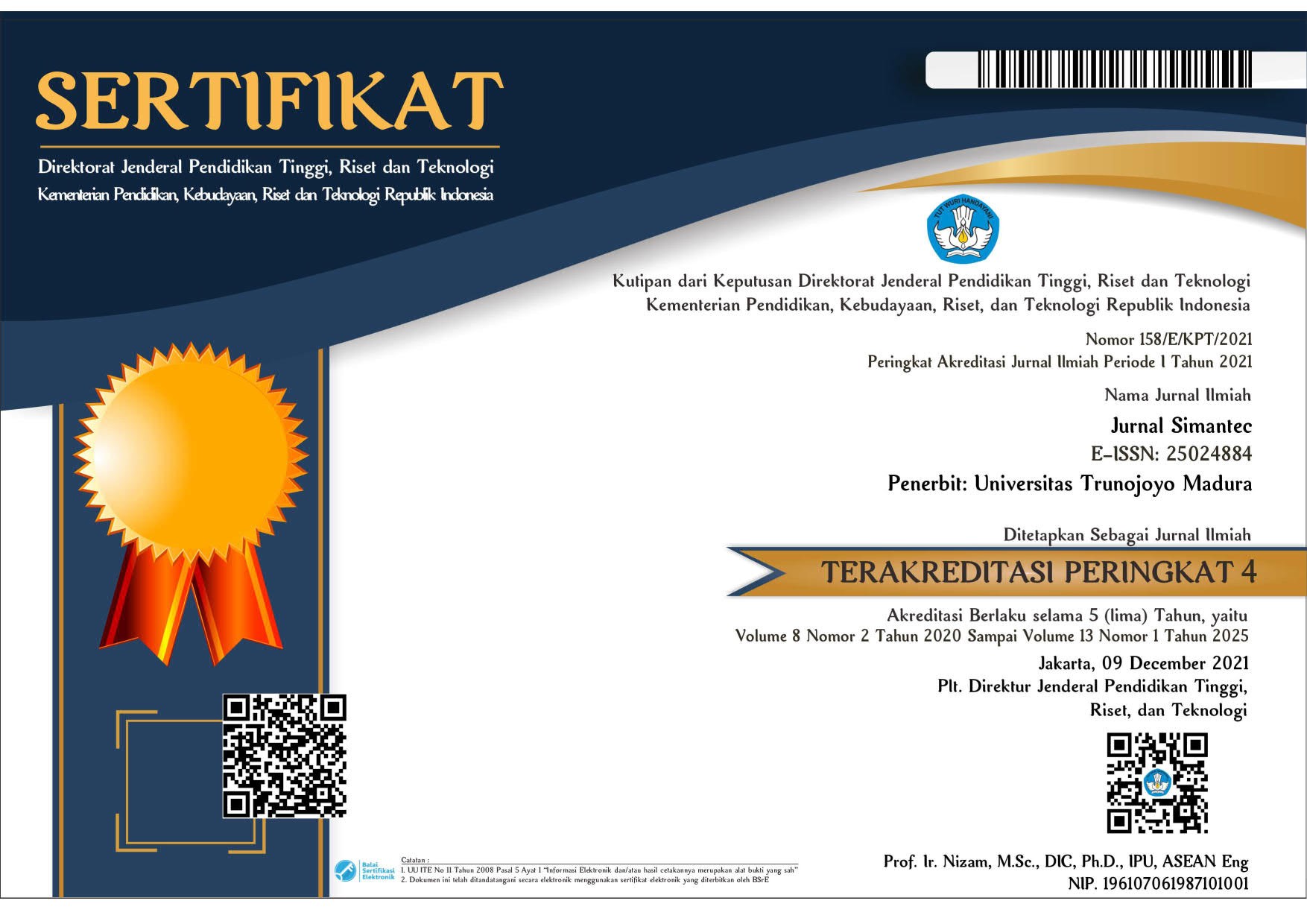Penerapan analisis sentimen opini masyarakat terhadap ulasan aplikasi Grab pada google play store menggunakan Algoritma Naive Bayes
Abstract
This study aims to analyze public sentiment regarding reviews of the Grab application on the Google Play Store using the Multinomial Naive Bayes algorithm. The research process follows the KDD stages, starting from data selection, pre-processing, sentiment labeling, dataset splitting, model training, to performance evaluation. A total of 5,000 review data were collected through web scraping techniques and processed step by step using cleaning, normalization, tokenizing, stopword removal, and stemming methods. The developed Multinomial Naive Bayes model was able to classify review sentiments into positive, negative, and neutral categories with an accuracy of 69.6%. Precision and recall for negative and positive sentiments are relatively high, but the performance for neutral sentiment remains low due to imbalanced data distribution. The results of this study provide valuable insights for Grab developers to understand user perceptions and can serve as a basis for strategic decision-making to improve application service quality. Thus, Multinomial Naive Bayes has proven to be effective and efficient for sentiment analysis of Grab app reviews on the Google Play Store.
Keywords: Sentiment Analysis, Multinomial Naive Bayes, Grab, Google Play Store, KDD
Full Text:
PDFReferences
A. Parisi et al., “Impact of COVID-19 pandemic on vaccine hesitancy and sentiment changes: A survey of healthcare workers in 12 countries,” Public Health, vol. 238, pp. 188–196, 2025, doi: https://doi.org/10.1016/j.puhe.2024.11.016.
M. Malik, D. A. Pangestu, and M. R. Pribadi, “Analisis Sentimen Hasil Pertandingan Sepakbola Timnas Indo- nesia di Piala Asia U-23 pada Platform Youtube menggunakan Algoritma Suport Vector Machine ( SVM ),” Appl. Inf. Technol. Comput. Sci., vol. 3, no. 1, pp. 38-45, 2024. https://doi.org/10.58466/aicoms.v3i1.1528
P. Chinnasamy, V. Suresh, K. Ramprathap, B. J. A. Jebamani, K. Srinivas Rao, and M. Shiva Kranthi, “COVID-19 vaccine sentiment analysis using public opinions on Twitter,” Mater. Today Proc., vol. 64, pp. 448–451, 2022, doi: https://doi.org/10.1016/j.matpr.2022.04.809.
Z. Hanif and U. Surapati, “Analisis Sentimen terhadap Perpanjangan Masa Jabatan Presiden: Lexicon Based dan Naive Bayes pada Analisis Sentimen Pengguna Twitter,” J. JTIK, vol. 9, no. 1, pp. 204–209, 2025. [Online]. Available: https://journal.lembagakita.org/index.php/jtik Doi: https://doi.org/10.35870/jtik.v9i1.3080
J. R. Jim, M. A. R. Talukder, P. Malakar, M. M. Kabir, K. Nur, and M. F. Mridha, “Recent advancements and challenges of NLP-based sentiment analysis: A state-of-the-art review,” Nat. Lang. Process. J., vol. 6, p. 100059, 2024, doi: https://doi.org/10.1016/j.nlp.2024.100059.
M. Badjrie, A. S. P. Sari, and R. S. Dewi, “Analisis Sentimen Berbasis Aspek pada Review Female Daily Menggunakan TF-IDF dan Naïve Bayes,” J. Media Inform. Budidarma, vol. 5, no. 2, pp. 422–430, 2021. [Online]. Available: https://ejurnal.stmik-budidarma.ac.id/index.php/mib Doi: https://doi.org/10.30865/mib.v5i2.2845
P. A. Henríquez and F. Alessandri, “Analyzing digital societal interactions and sentiment classification in Twitter (X) during critical events in Chile,” Heliyon, vol. 10, no. 12, p. e32572, 2024, doi: https://doi.org/10.1016/j.heliyon.2024.e32572.
M. Isnan, G. N. Elwirehardja, and B. Pardamean, “Sentiment Analysis for TikTok Review Using VADER Sentiment and SVM Model,” Procedia Comput. Sci., vol. 227, pp. 168-175, 2023, doi: https://doi.org/10.1016/j.procs.2023.10.514.
H. T. Wijaya, A. Info, and N. Bayes, “Sentiment Analysis of Twitter Users Towards Kartu Prakerja Program Using the Naive Bayes Method,” Int. J. Adv. Data Inf. Syst., vol. 5, no. 2, pp. 242-252, 2024, doi: 10.59395/ijadis.v5i2.1342 https://doi.org/10.59395/ijadis.v5i2.1342
R. Jufri, E. Yuliana, and E. S. Sari, “Analysis of Public Sentiment on Google Play Store Tije Application Users Using Naïve Bayes Classifier Method,” JUTIF, vol. 5, no. 1, pp. 243–251, 2024. [Online]. Available: https://jutif.if.unsoed.ac.id/index.php/jurnal Doi: https://doi.org/10.52436/1.jutif.2024.5.1.1648
T. W. Putra and A. , Agung Triayudi, “Analisis Sentimen Pembelajaran Daring menggunakan Metode Naïve Bayes , KNN , dan Decision Tree,” J. Teknol. Inf. dan Komun., vol. 6, no. 1, 2022, doi: https://doi.org/10.35870/jtik.v6i1.368.
R. P. Tanjung, A. Purwoko, and R. A. Lubis, “Naives Bayes Algorithm for Twitter Sentiment Analysis,” J. Phys. Conf. Ser., vol. 1933, no. 012019, pp. 1-6, 2021, doi: 10.1088/1742-6596/1933/1/012019. https://doi.org/10.1088/1742-6596/1933/1/012019
N. A. Putri, A. Srirahayu, and N. A. Sudibyo, “Analisis Sentimen Terhadap Aplikasi KitaLulus Menggunakan Metode Naive Bayes dari Ulasan Google Play Store Sentiment Analysis of the KitaLulus Application Using the Naive Bayes Method from Google Play Store Reviews,” Smart Comp Jurnalnya Orang Pint. Komput., vol. 14, no. 105, pp. 269-279, 2025, doi: 10.30591/smartcomp.v14i2.7230. https://doi.org/10.30591/smartcomp.v14i2.7230
D. Rizki, S. Pratama, T. A. Munandar, and K. Fadhilla, “Multinomial Naive Bayes Algorithm for Indonesian language Sentiment Classification Related to Jakarta International Stadium ( JIS ),” Int. J. Inf. Technol. Comput. Sci. Appl., vol. 2, no. 1, pp. 12–22, 2024, doi: https://doi.org/10.58776/ijitcsa.v2i1.118.
Y. Chen, H. Wang, and L. Zhang, “Sentiment Analysis of Public Opinion on Presidential Advisory Appointments Using Naive Bayes Classification,” JIITUJ, vol. 8, no. 2, pp. 110–120, 2024. [Online]. Available: https://jiitujournal.com/index.php/jiituj Doi: https://doi.org/10.22437/jiituj.v8i2.35254
I. Gustina and A. Yudhistira, “Analisis Sentimen Program Coding Anak SD Menggunakan Metode Naive Bayes Sistem Informasi , Fakultas Teknik dan Ilmu Komputer , Universitas Teknokrat Indonesia , Indonesia Sentiment Analysis of Elementary School Children ' s Coding Program Using the Naive,” J. Pendidik. dan Teknol. Indones., vol. 5, no. 2, pp. 505-514, 2025, doi: https://doi.org/10.52436/1.jpti.668.
C. Dewi, R.-C. Chen, H. J. Christanto, and F. Cauteruccio, “Multinomial Naïve Bayes Classifier for Sentiment Analysis of Internet Movie Database,” Vietnam J. Comput. Sci., vol. 10, no. 04, pp. 485-498, 2023, doi: 10.1142/S2196888823500100. https://doi.org/10.1142/S2196888823500100
N. Umar and M. A. Nur, “Application of Naïve Bayes Algorithm Variations on Indonesian General Election Analysis Dataset for Sentiment Analysis,” J. RESTI, vol. 6, no. 4, pp. 585–590, 2022. [Online]. Available: https://jresti.ikmi.ac.id/index.php/jresti Doi: https://doi.org/10.29207/resti.v6i4.4179
A. Falasari and M. A. Muslim, “Optimize Naïve Bayes Classifier Using Chi Square and Term Frequency Inverse Document Frequency For Amazon Review Sentiment Analysis,” J. Soft Comput. Explor., vol. 3, no. 1, pp. 31–36, 2022. [Online]. Available: https://jurnal.iaii.or.id/index.php/SCE Doi: https://doi.org/10.52465/joscex.v3i1.68
W. B. Zulfikar, A. R. Atmadja, and S. F. Pratama, “Sentiment Analysis on Social Media Against Public Policy Using Multinomial Naive Bayes,” Sci. J. Informatics, vol. 10, no. 1, pp. 25-34, 2023, doi: 10.15294/sji.v10i1.39952. https://doi.org/10.15294/sji.v10i1.39952
DOI: https://doi.org/10.21107/simantec.v14i1.29886
Refbacks
- There are currently no refbacks.
Copyright (c) 2025 Bella Audrey Zadia
Indexed By
.png)

11.png)













